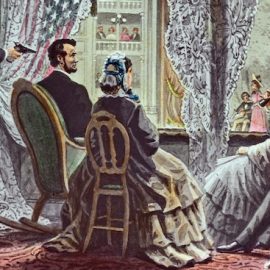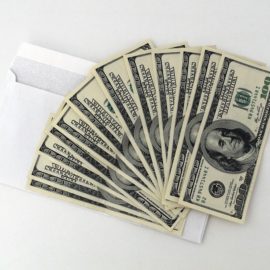

This article is an excerpt from the Shortform book guide to "The Wolf of Wall Street" by Jordan Belfort. Shortform has the world's best summaries and analyses of books you should be reading.
Like this article? Sign up for a free trial here.
What’s The Wolf of Wall Street by Jordan Belfort about? How did Belfort’s lifestyle cause him to lose his power?
In The Wolf of Wall Street, Jordan Belfort explains how he grew his wealth through stock manipulation and money laundering and attempted to evade prosecution through his crimes. He also delves into his lifestyle of drug abuse and self-indulgence that almost killed him.
Read below for a brief overview of The Wolf of Wall Street.
The Wolf of Wall Street by Jordan Belfort
“Sex, drugs, and stock manipulation” aren’t words that most people normally string together, but that was the world of Jordan Belfort and his New York brokerage firm, Stratton Oakmont. Belfort and his staff of young traders challenged the long-established firms of Wall Street and enriched themselves to an outlandish degree with unprincipled—and often illegal—trading practices. Beyond that, Belfort and Stratton Oakmont’s traders used their wealth to indulge their every hedonistic whim, fueling a cottage industry of vice in a Long Island community that was previously a staid enclave of old money.
In the 2007 book The Wolf of Wall Street, Jordan Belfort confesses his illegal actions, both in high finance and his personal life, which led to a self-destructive spiral into drug addiction and life-threatening behavior. Belfort’s actions eventually resulted in his arrest, but not before endangering himself, his friends, and his family. The book was later adapted into a 2013 film by Martin Scorsese.
Barred from securities trading for life, Belfort now works as a motivational speaker. His book The Way of the Wolf explains Belfort’s “Straight Line” method of selling, which uses psychological techniques to move a customer from doubt to certainty about whether they want to make a purchase. Despite his fraud conviction and his time spent in prison, Belfort is still a multimillionaire with an interest in cryptocurrency.
Meet Jordan Belfort
Though Belfort’s memoir starts at the height of his power, he provides snippets throughout that describe his life before Wall Street and illustrate how success affected him. In this section, we’ll take a glimpse at Belfort’s early days, his lifestyle once he’d achieved massive wealth, and the emotional turmoil he hid behind his mask.
Belfort provides a brief biographical sketch of his early life—his father was at turns abusive and caring, and his mother did nothing to protect him. As a child, he was always at the top of his class, but even then he was plagued by insomnia, anxiety, and a mind that wouldn’t stop racing. In college, he dropped out of dental school when he learned that dentistry was no longer a path toward guaranteed riches. He started a business in food services that failed, and he also met his first wife—whom he’d cheat on and later divorce—and eventually entered the stock trading game at the firm LF Rothschild in 1987 during the heyday of the bond securities market.
By 1993, when Belfort’s narrative begins, he’d established his own investment firm, Stratton Oakmont, situated on Long Island, New York, not Wall Street itself. Even though he’d remarried—to the model Nadine Cardi—his life was filled with parties, prostitutes, and drugs. Belfort contends that sex and substance abuse were common ways for Wall Street traders to cope with their stressful jobs.
The Long Island Boys’ Club
Belfort wasn’t alone in the wild life he led—he cultivated an organizational culture to embody it. Being a member of his Stratton Oakmont team wasn’t just about making money, but also spending it in the most outlandish ways possible. Belfort details the example he set for Stratton Oakmont’s cadre of brokers, the type of lifestyle he encouraged them to lead, and how he used that lifestyle to control them. Thanks to the electronic NASDAQ stock exchange, it was no longer necessary for investment firms to be physically located on Wall Street, so Belfort founded Stratton Oakmont on nearby Long Island in 1989.
To fill Stratton Oakmont’s desks, Belfort says he deliberately recruited young, malleable traders and indoctrinated them into his way of thinking, the tenets of which were as follows:
- Money is the solution to every single problem.
- It’s vital to make money while you’re young and still able.
- If you act like you’re already rich, then the universe will make it so.
In addition to Belfort’s basic principles, he told his brokers that the point of getting rich was to indulge your every fantasy and whim. To that end, he led by example and encouraged his brokers to do the same—buying expensive houses, cars, and boats; going to expensive clubs and restaurants; engaging in high-adrenaline pastimes, and indulging themselves with drugs and prostitutes. In what was once a staid, refined Long Island small town, Stratton Oakmont’s brokers supported a whole cottage industry of gambling, vice, and the sale of high-end goods. The behavior of Stratton Oakmont staff grew so extreme that Belfort recalls having to send a memo asking staff not to have sex on company property during working hours.
Belfort writes that he encouraged this behavior to keep his traders competitive and hungry, even as they raked in millions of dollars. Belfort wanted his employees to spend their money as quickly as they made it, keeping them on the hook to Stratton Oakmont and dependent on him as their leader. The flaw that Belfort discovered in this plan was that since he had to lead by example, he was just as trapped by his lifestyle as his brokers. Once he’d established his “Wolf of Wall Street” persona, he was expected to maintain it. If he didn’t party, have promiscuous sex, and take every drug known to mankind, his staff would have seen it as a sign of weakness.
Financial Crimes
Though Belfort did many things that were against the law, it was his financial crimes that both enriched him and eventually sent him to prison. So many of Belfort’s business dealings were against federal and state regulations that a significant amount of his time was spent inventing schemes to hide his transactions from regulatory institutions. Here, we’ll look at the principles upon which Belfort’s firm, Stratton Oakmont, was founded, the mechanisms by which it manipulated stock prices, and how Belfort attempted to conceal his gains by laundering his money through the Swiss banking system.
Belfort writes that stockbrokers like himself don’t actually create anything of value, nor do they have any specialized knowledge that gives them insight into the stock market. He says that at heart, stockbrokers are nothing more than sleazy salesmen, and that any kid out of high school or college can be trained to sound like a stock market guru. And thus, he created Stratton Oakmont as a firm comprising young, hungry traders with little financial knowledge but with plenty of motivation to make sale after sale.
Unlike other unscrupulous traders who preyed on poor investors with what were known as “penny stocks,” Stratton Oakmont made money by preying on the wealthy using inflated stocks that they sold as get-rich-quick schemes. Belfort argues that this strategy worked because most rich people are compulsive gamblers for whom playing at stocks is like going to a casino. Therefore, it’s easy to sell them sketchy stocks, and they trade at higher volumes than less affluent investors. This strategy also confused the Securities and Exchange Commission (SEC), which investigated Stratton Oakmont for years without really understanding the true nature of its business.
Stock Manipulation
While there are many ways for investment firms to make money, the practice of choice for Stratton Oakmont was stock price manipulation. Belfort’s traders would artificially inflate the stock price of a company during its Initial Public Offering (IPO) while holding on to more shares of that company than was allowed by SEC rules. Belfort illustrates this with the specific example of Steve Madden Shoes, a company that he helped to take public.
Belfort explains how stock manipulation during an IPO works: He’d heavily invest in a new business, such as Steve Madden Shoes, then use his controlling interest to take the company public. Belfort’s brokers would use every strong-arm trick they knew to drive the price up when selling to investors. Once the price had gone high enough, Belfort would sell enough of his shares to recoup the cost of his initial investment—meaning that he paid nothing for the stocks he retained, which were now valued higher than ever. However, by SEC rules, an investment firm sponsoring an IPO is only allowed to own a limited stake in the company whose shares they’re selling—but Belfort and Stratton Oakmont held on to far more Madden stock than they were legally allowed.
Money Laundering
While it’s one thing to make illicit riches, hiding and accessing your money once you’ve earned it poses a new set of problems. Money laundering—the process of converting wealth obtained illegally into seemingly legitimate income—is an industry that Belfort says the Swiss banking system is particularly geared toward, using secret accounts, fictitious corporations, and covert mechanisms to transfer money back to the US under the guise of innocuous transactions.
Belfort traveled to Switzerland in secret, but once he was there, the bankers he met spoke openly about how the Swiss banking system conceals huge sums of money and how it’s their policy to not cooperate with foreign institutions, such as the US’s SEC. Because the practice of issuing “numbered” bank accounts with no name attached stopped after World War II, Belfort’s first step was to open accounts in the names of proxies, much like those who held his stock. These people would have the unenviable task of smuggling large amounts of cash across the border, so Belfort had to use people he could trust who were also unlikely to arouse suspicion—including his elderly British aunt and one of his drug dealers’ Swiss extended family.
To access and control his overseas funds, Belfort writes that his bankers introduced him to a specialist in creating fictitious corporations. This person would generate “bearer companies” that wouldn’t have Belfort’s name on them at all—ownership would be established through physical stock certificates that Belfort would possess. This person would act as Belfort’s corporate proxy, falsifying documents to make his companies look real and conducting business on Belfort’s behalf. For anything Belfort wanted to do—for example, transferring funds from business A to B—this specialist would concoct a paper trail to make the transfer seem justified.
Belfort lists two ways these fake corporations let him move money back to the US. One was by using a US legal loophole called Regulation S, which exempted overseas companies from certain restrictions on US investors. By going through his Swiss businesses, Belfort could invest in the US stock market in ways that he couldn’t as a US citizen. The other way of moving his money back home was through a practice called “transfer pricing,” in which one of his overseas companies would overpay a US business he owned for services or merchandise that may not even exist except on paper. By creating fake companies all over the world, Belfort could move money anywhere under the guise of seemingly mundane business dealings.
The Consequences of Belfort’s Lifestyle
Despite the fact that it was his financial misdealings that eventually landed Belfort in prison, it was his excessive lifestyle that almost destroyed him before the law caught up. Belfort’s addictions to drugs, sex, and risk-taking behavior continued to dominate his life even after he left Stratton Oakmont behind. Belfort describes his half-hearted attempt to back away from the firm to avoid prosecution, how his life during his “early retirement” became a downward spiral of drug use, depression, and self-destruction, and how he was eventually forced to choose between rehab and death.
The Getaway Attempt
In 1994, the SEC offered Belfort a deal that would have given him an escape from Stratton Oakmont and its whirlwind of chaos. The SEC agreed to end its criminal investigation if Belfort stepped away from his firm and left securities trading for good. Belfort would reluctantly take the SEC’s deal, but he wouldn’t honor it in spirit—instead setting himself up as an outside adviser who’d help to steer Stratton Oakmont from behind the scenes.
After years of trying to pin Stratton Oakmont down for stock manipulation, the SEC grew tired of pursuing its case and offered to let Belfort settle out of court if he agreed to a token $3 million fine and to leave the brokerage industry forever. Belfort writes that he didn’t believe the SEC had a solid case to make against him, but his lawyers persuaded him that if the investigation kept going on, it would eventually turn up something damning. Therefore, he agreed to step aside and hand the reins of the firm to Danny Porush, who’d always been his right-hand man—and whose wild behavior outmatched Belfort’s. Belfort would be free to enjoy his fortune, along with his wife, his young children, and their friends.
More than just an escape from prosecution, the SEC’s deal could have given Belfort a graceful exit from the extravagant culture he’d created, but the thought of leaving the stock trading business never crossed Belfort’s mind. Rather, Belfort chose to stay in the game as a private investor while setting up an office next door to Stratton Oakmont, acting as the firm’s back-room adviser. Belfort says he was overjoyed that he’d no longer have to trade stock through proxies—as a private individual, he’d be able to trade as much as he wanted without having to hide his transactions.
Alas, Belfort writes that all wasn’t well in his new paradise. Madden, Belfort’s proxy owner of Steve Madden Shoes, began to show signs that he wouldn’t turn over the stock he’d been holding on Belfort’s behalf. Meanwhile, Belfort started hearing rumors about Porush’s mismanagement of Stratton Oakmont. To top it all off, as soon as the SEC investigation closed, Belfort learned that the FBI had begun its own investigation—this one aimed at him and not his former firm.
The Downward Spiral
Despite Belfort’s previous assertion that money was able to solve any problem, his riches did nothing but fuel his drug use and enabled him to endanger himself in ways that only the super-wealthy can. Belfort recounts his worsening drug addiction, the self-destructive behavior it inspired, and the damage done to his family life, and his head-on collision with depression and attempted suicide before giving in to professional help.
Belfort says that while he’s done many drugs, his primary addictions were to sex and to methaqualone, commonly known as “Quaalude,” which was prescribed to him after a back injury. He eventually became hooked on the pills and used them for their high instead of pain relief. Belfort was on a particularly strong Quaalude high when he learned that the FBI was after him for money laundering. He rushed home, delirious on drugs, crashed into seven cars, and injured one person. For once, the police arrested Belfort, though as always before, he suffered no consequences—this time thanks to a friend who knew a judge.
In 1996, Belfort’s doctors found a way to treat his pain without the use of Quaaludes, but that didn’t stop Belfort from using them. He, his wife, and their friends went to Rome, where he and his friends were so high on drugs that Belfort insisted his yacht be put to sea in the face of an oncoming storm. The storm turned into a massive gale with 50-foot waves, endangering the lives of everyone onboard, though Belfort recalls that he and his friends prioritized saving their drugs over themselves. The Italian navy rescued Belfort and his crew shortly before his yacht sank in the storm, and even though Belfort would not be held accountable, he promised himself and his wife he’d quit the Quaaludes.
Rock Bottom and Recovery
Belfort had hit the lowest point of his life. Since drugs had become his only refuge, he couldn’t see any way out of his situation that didn’t involve drugs as part of the solution. Belfort describes his head-on collision with depression and attempted suicide before giving in to professional help, as well as the peace and self-awareness that came after.
In a fit of anger and depression, Belfort attempted suicide by taking morphine pills, though he argues that it wasn’t a real suicide attempt because he knew a friend of his was near and would be able to save him. After having the morphine pumped out of his system, Belfort was placed on an involuntary psychiatric hold, during which Nadine arranged for an intervention—she let Belfort know that unless he went to rehab, he’d never see her again. Belfort’s interventionist explained that he and Nadine were deeply codependent in that she’d been enabling his rampant drug use while he took advantage of his power in their marriage.
Once in rehab, Belfort asserts that his urge to do drugs simply turned itself off, though he felt his sex addiction would remain more of a problem. He slowly opened up to his fellow rehab patients, while admitting to himself that he ought to be dead from the sheer amount of drugs he’d been taking. He returned to New York where he was able to stay sober, though his recovery sponsor pointed out to him that even though he’d stopped using drugs, he was still in danger of repeating the behaviors that he’d used the drugs to justify.
Nevertheless, Belfort recalls that those first sober months were the clearest, happiest, and healthiest he’d had in over 10 years. He worked on trying to repair his marriage, spend time with his children, and explore his new reality. Many of his old friends drifted away, and his relationships with the ones who stayed changed. Stratton Oakmont had long since closed down, and Belfort’s other financial streams folded. He didn’t care—he was sober, rich, and happy—until September 1998, when the FBI arrested him for money laundering and fraud, shortly after which, Nadine filed for divorce.

———End of Preview———
Like what you just read? Read the rest of the world's best book summary and analysis of Jordan Belfort's "The Wolf of Wall Street" at Shortform.
Here's what you'll find in our full The Wolf of Wall Street summary:
- How Jordan Belfort grew his wealth through stock manipulation and money laundering
- How Belfort's lifestyle of drug abuse and self-indulgence almost killed him
- Proof that money can't buy happiness






